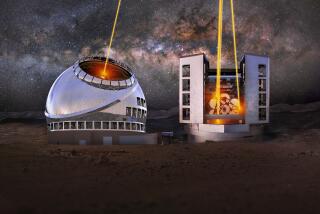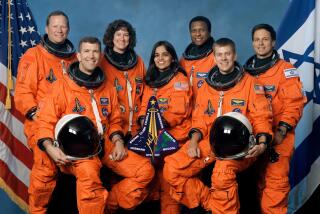A Heavenly Opportunity : KCET Hopes ‘Astronomers’ Will Atone for ‘Cosmos’ Debacle
- Share via
The scientists whose tales propel “The Astronomers,” the rich newPBS series produced by Los Angeles public-television station KCET, date the Big Bang--the explosion believed to have started the universe--at 15 billion years ago.
We and our world, as astronomer Mike Dopita puts it in the fifth episode of the series, which debuts Monday night, are “just a product of stardust.” Our molecules are made of so much cosmic debris.
At KCET, a Big Bang of a different sort occurred much more recently--and the memories are painful. A decade ago, the station’s own comfortable universe exploded with a financial debacle that was linked, ironically, to “Cosmos,” KCET’s last attempt to produce a national science series.
With “The Astronomers,” station officials are hoping that, just as the cosmic debris of the universe came together to form flowers and trees and even people, so the stardust at Channel 28 will finally settle, too--and perhaps even flower.
The series is KCET’s most ambitious effort since “Cosmos” in 1980. Partly as a result of deficits incurred on that program, Channel 28 became mired in a financial crisis that resulted in 77 layoffs, a 50% reduction in the station’s budget and the forced resignation in 1982 of longtime station President James Loper.
Now the station is counting on “The Astronomers” to launch it back into orbit as a major producer of public-television shows, a goal that has eluded current President William Kobin, who took over in 1983.
“It’s proved to be harder to make that kind of programming than I had hoped,” Kobin said. “We started from zero. We had shut down. And to raise the money and build the staff took a lot longer than I expected.”
If “The Astronomers”--which was purposely developed as a limited series with only six episodes--succeeds, KCET plans to follow it with ongoing annual journeys into the lives of scientists in different disciplines. The station is also developing a 10-part series on the history of Hollywood films and a Bill Moyers special about Los Angeles.
With “The Astronomers,” KCET is taking an unusual approach to science programming. Instead of tracking the dry stuff of theories and formulas through textbook-style narration accented by charts and graphs, the six-part series takes viewers into the lives of individual astronomers as they travel the world in search of scientific answers.
The story of the universe is interwoven with the lives of the scientists themselves. And with their passion for explaining the seemingly unexplainable, their voyages to mountaintops and desolate deserts, these explorers of astrophysics are presented more like poets and mystics than hard-boiled technocrats or stereotypical academics.
“I want to find out how the world is made--what it’s made of, what brought it together, what makes it operate the way it does,” declares astronomer Hans Bethe, whom narrator Richard Chamberlain describes as “the man who discovered how stars shine” in 1938.
To some degree, the beginnings of the stories of “Cosmos” and “The Astronomers” are the same: Interested in science and drawn to its mystical side, producers at KCET make a pitch for a program about astronomy. The money is raised. Production begins, but a recession hits just as the program is about to air.
Kobin, who came to KCET in 1983 to clean up the mess left by the post-”Cosmos” financial woes, insists that the similarity ends there:
“The fact that ‘Cosmos’ came out of KCET and this series comes out of KCET is truly an accident. Most of us don’t even have a history with KCET before ‘Cosmos.’ ”
Indeed, there are marked differences between the projects. “Cosmos”--whose 13 episodes cost $8.2 million to produce and distribute--was under-funded by $1 million, and ran an additional $500,000 over budget. “The Astronomers,” on the other hand, was funded by a single grant from the W.M. Keck Foundation. The foundation’s gift of $5.3 million covered not only the production costs, but also the expenses for promotion, educational materials and preparation and distribution of videocassettes.
“The Astronomers” “was tracked extremely carefully, very, very closely,” Kobin said. “There was a report distributed to the finance committee at every meeting.”
In addition, Kobin said, the station put aside extra money from its own budget as a contingency fund, in case “The Astronomers” went over budget. (It did not.)
Because the financing for “The Astronomers” was in place so early, and because it covered promotion and videocassettes as well as production, the program’s premiere has been coordinated in a way never before possible for a public-television series.
For the first time, tapes of the series will be available in video stores on the day the first episode is shown. Hard-cover companion books are already available in bookstores. And 9,400 high schools around the country have already received ancillary materials designed to help incorporate the program into science curricula.
“It’s the first time we’re able to bring all of the marketing forces and all of the potential ways to expose the product to one clear focal point,” said video pioneer Michael Nesmith, whose company, Pacific Arts Video, is distributing tapes of the series along with PBS Home Video, with which Nesmith also is affiliated.
“Direct response, mail order, everything--it’s all happening at the same time, all going ‘boom’ on April 15,” Nesmith said.
Having the financing in place ahead of time also helped the actual production, said executive producer Blaine Baggett. It was only because producers knew that they would have about $4 million to produce six programs that they were able to budget the time to document thoroughly the lives of the astronomers who were interviewed.
“Most of the time with science programs, all you have the ability to do is interview a scientist who sits in front of a wall of books,” Baggett said. “Thanks to the money, what you see (in ‘The Astronomers’) is these guys in action.”
The key to making the science in to a human story, Baggett said, was the astronomers themselves: By using an oral history approach, and by literally taking the camera aboard planes, trains and automobiles with the scientists, the viewer feels a sense of movement.
Throughout the series, the camera moves: down the road, dodging in and out of scenes of family gatherings, sweeping across panoramas of sky and sea. Astronomers are depicted at carnivals, watching fireworks and--accompanied by passionate dialogue and enthusiastic gestures--at their computers.
When the telling of the scientific story requires a change in subject, the series switches to a different astronomer--one who studies the subject in question.
With the oral histories, scripts and camera work in place, translating astronomy and physics to television required one more ingredient: sophisticated--and expensive--computer animation.
In 1980, the special effects for “Cosmos” consisted essentially of still images on transparencies. The camera would pan from one portion of the image to another.
But 11 years and $1 million later, “The Astronomers” can take viewers on a multicolor tour of a galaxy with a black hole in it, or dive into the center of an exploding supernova.
The animation in “The Astronomers” doesn’t look like the special effects in big-budget science-fiction movies, but it is beautiful. And, more important, it was screened by a committee of scientists for accuracy.
“In a science-fiction movie, the emphasis is going to be on artistic license and entertainment value,” said Steve Wright, co-owner of Sidley Wright & Associates, one of three animation companies that worked on the series. “They will abuse the science, as long as they don’t abuse it so badly that the audience stops watching.” That luxury was not available on “The Astronomers.”
For each image, Wright said, his staff consulted for two to three hours with the series’ science advisory panel, which was made up of nine astronomers and physicists from California universities.
But “The Astronomers” is not without potential for controversy.
The underwriting Keck Foundation, which was founded by late oil baron William Myron Keck with proceeds from his Superior Oil Co., is building one of the largest telescopes in the world on the volcanic Mauna Kea in Hawaii. Also working on the telescope are scientists at Caltech and JPL, some of whom are involved with the series.
The Keck telescope--called “the mighty Keck” by a scientist in the series--is featured for about three minutes in the first episode, with a total of about 10 minutes devoted to Mauna Kea itself as a site for observing the heavens.
The Keck telescope is also featured on a 12-minute promotional reel that the station made about the series.
PBS guidelines discourage producers of public-television programs from accepting funding from organizations that either have or appear to have a vested interest in the subject of the program. In the past, some programs have been rejected by the network if the funding appeared to be inappropriate.
Baggett said that the question of whether it was appropriate to accept funding from Keck was never discussed at KCET.
Keck representatives, he said, did ask how the program would treat the Keck telescope, “but they only asked once.”
For Baggett, however, the making of “The Astronomers” had little to do with proving a point about “Cosmos” or the Keck telescope--except that it’s a big, important telescope.
Throughout his career, the Mississippian has wanted to touch the stars. In 1985, he produced “Spaceflight,” an oral history-based documentary about astronauts that became the inspiration for “The Astronomers.” He is a finalist for NASA’s Journalist in Space program.






